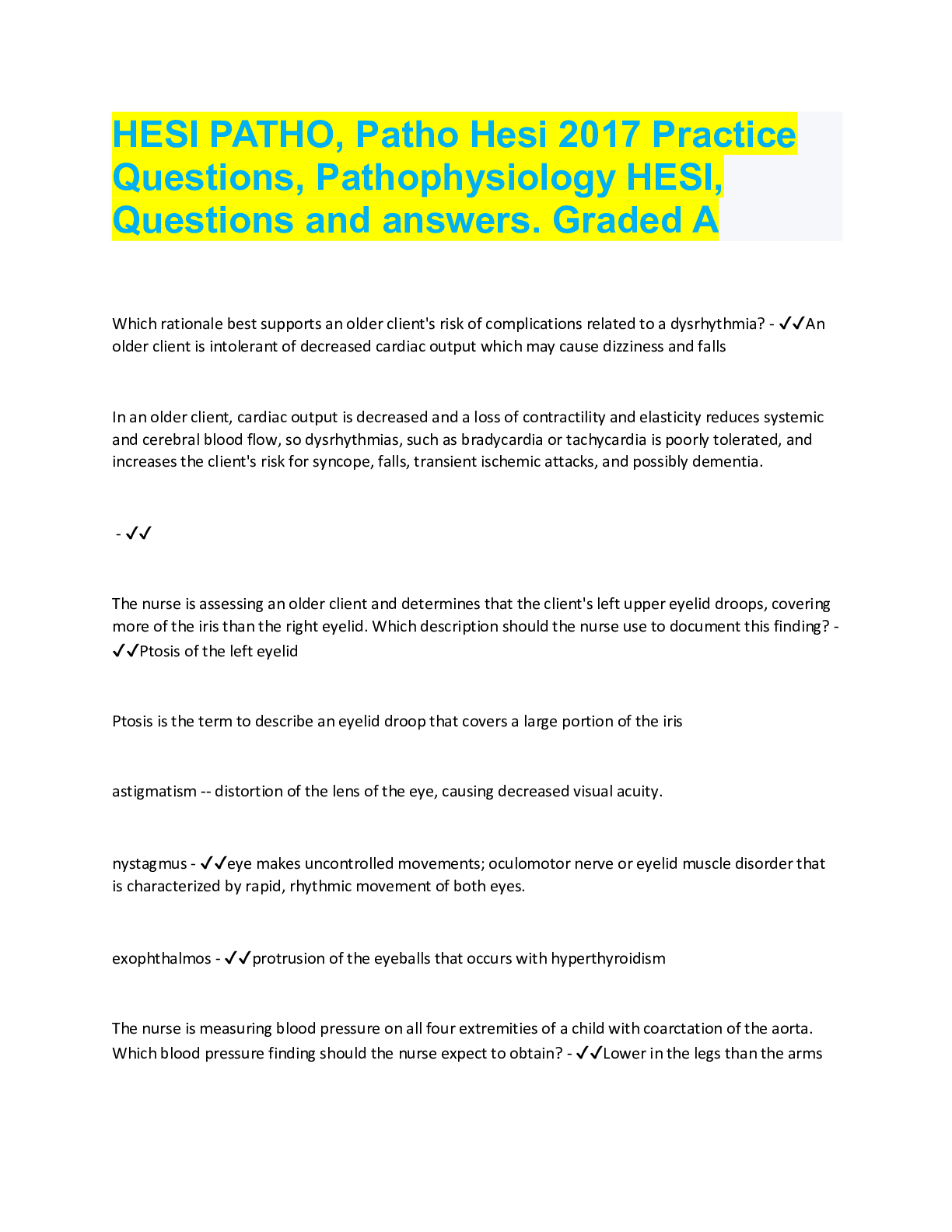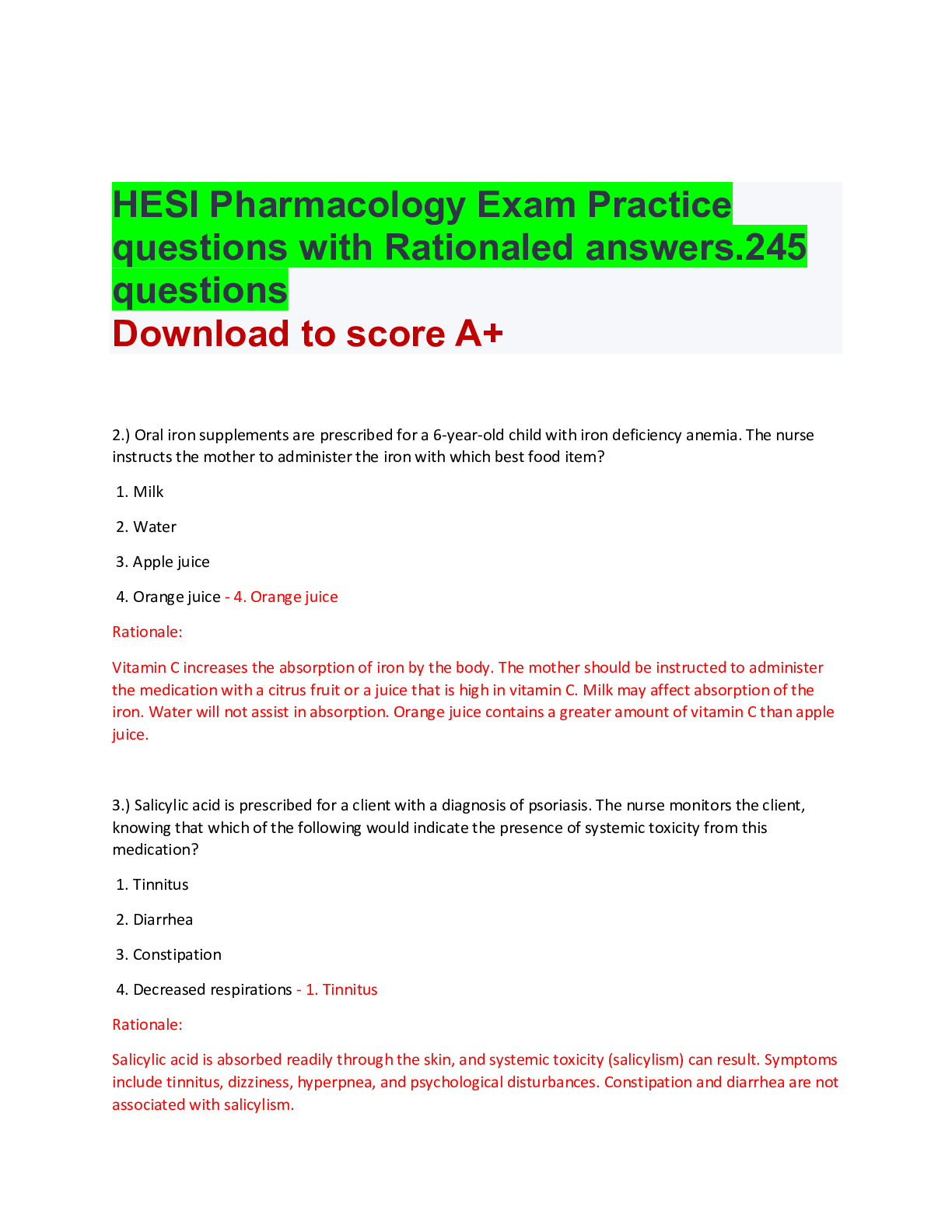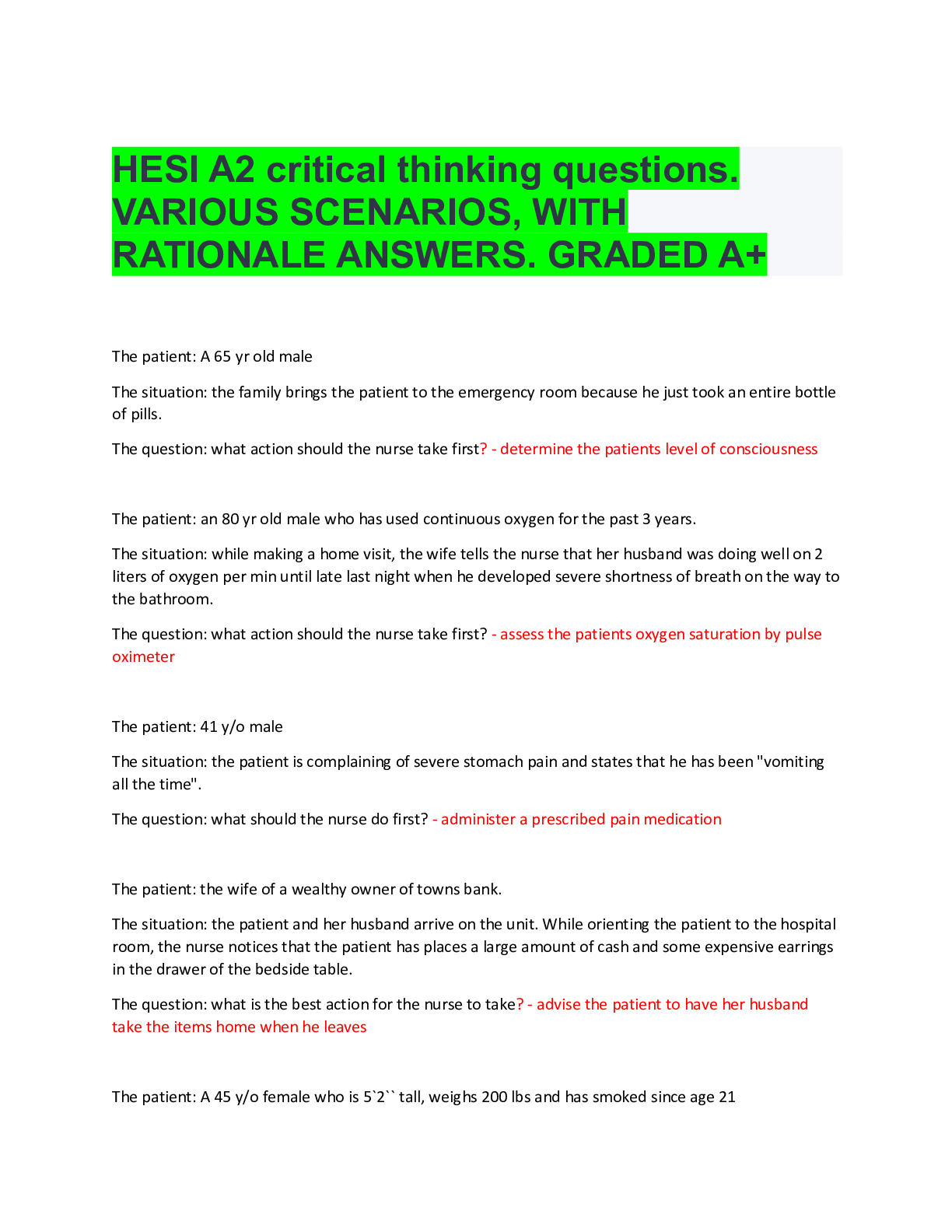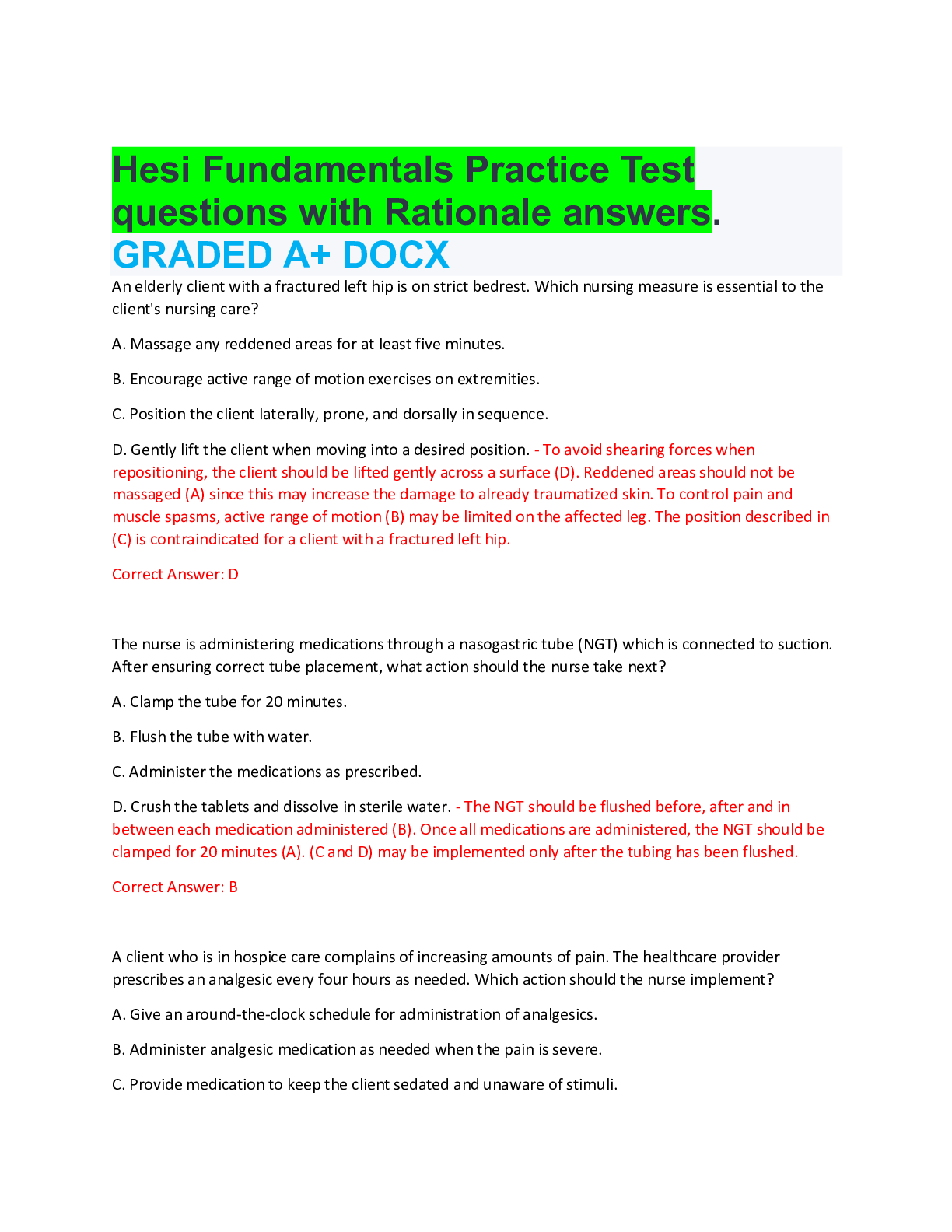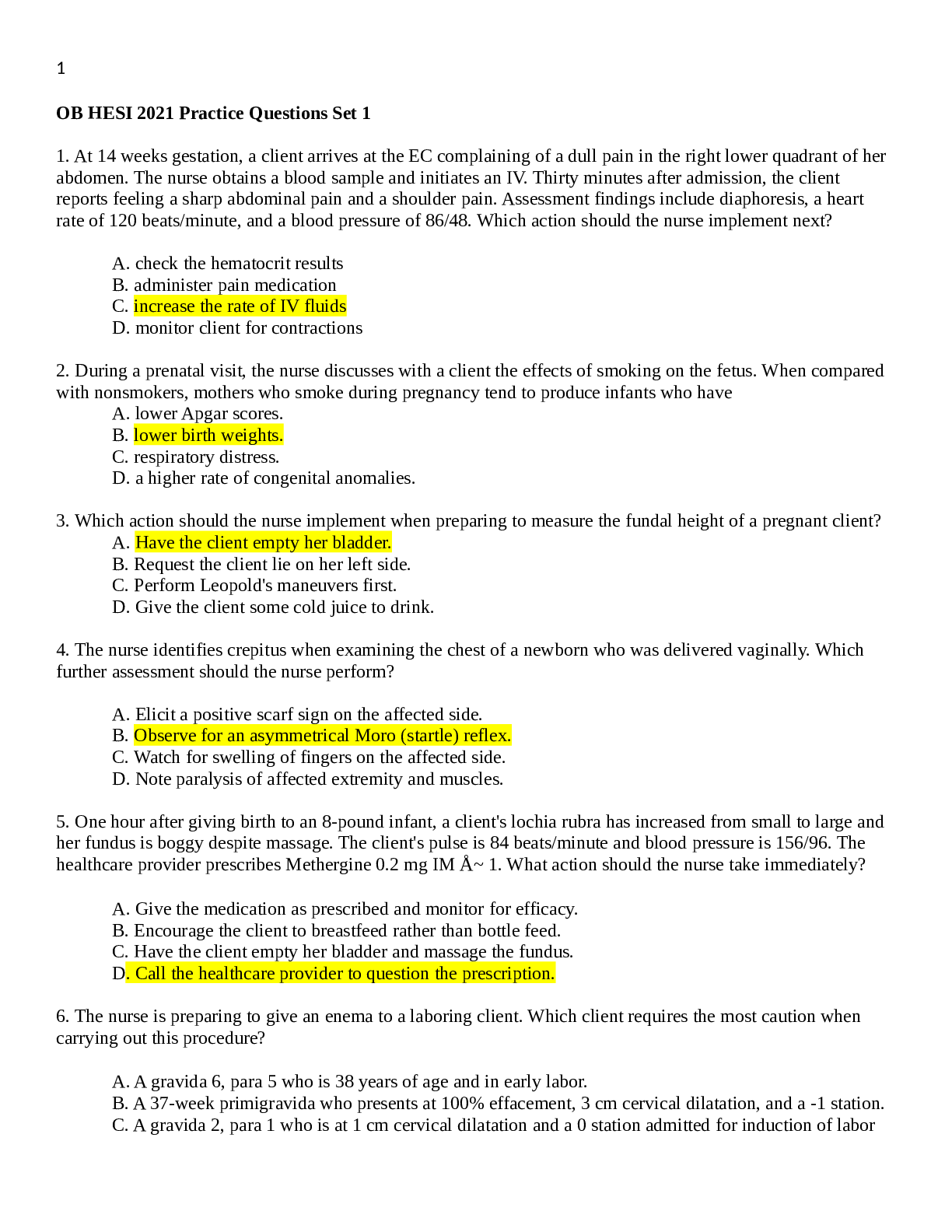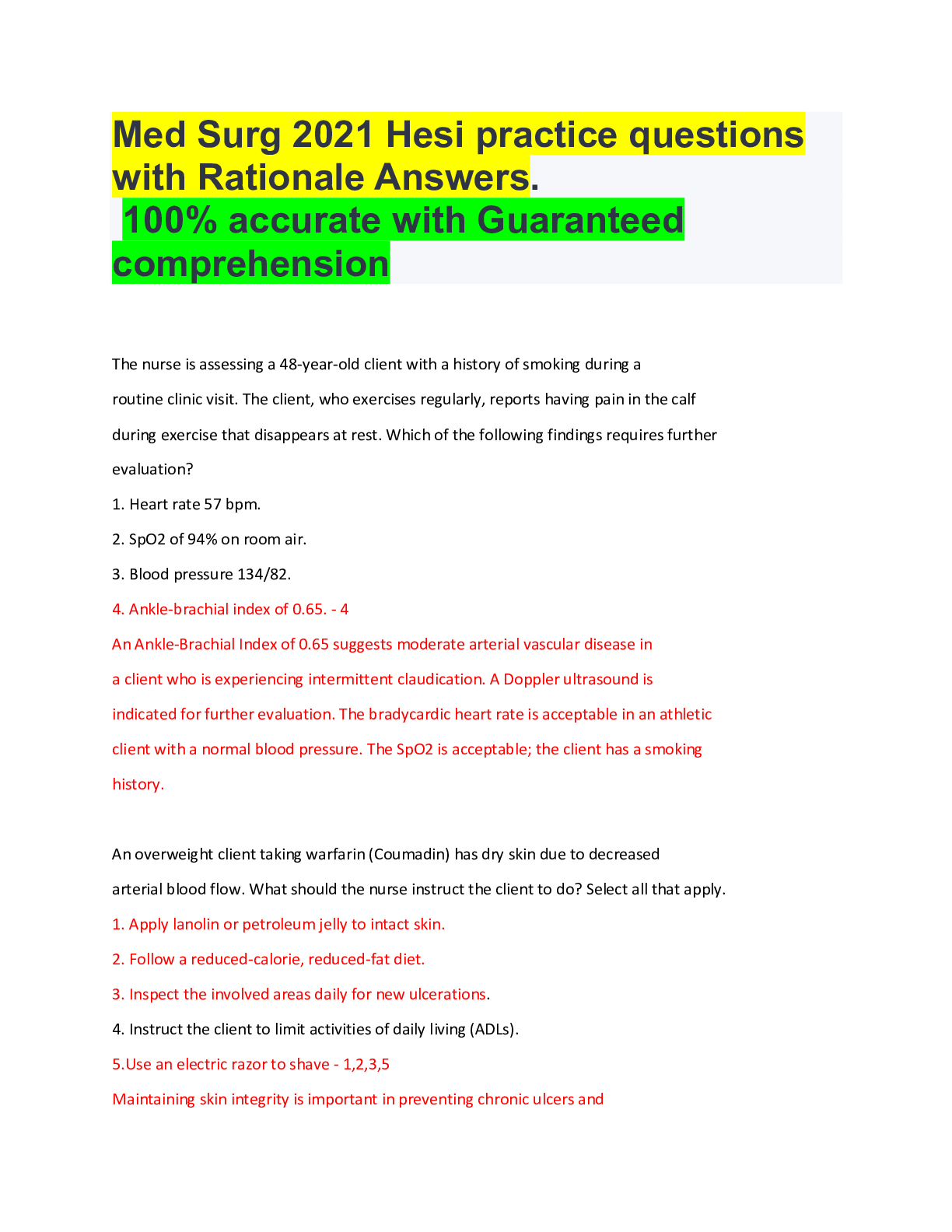Patho Hesi 2021 Practice Questions with rationale answers. Graded A+
Document Content and Description Below
The nurse hears short, high-pitched sounds just before the end of inspiration in the right and left lower lobes when auscultating a client's lungs. How should this finding be recorded? A. Inspiratory... wheezes in both lungs B. Crackles in the right and left lower lobes C. Abdominal lung sounds in the bases of both lungs D. Pleural friction rub in the right and left lower lobes - B Fine crackles are short, high pitched sounds heard just before the end of inspiration that are the result of rapid equalization of pressure when collapsed alveoli or terminal bronchioles suddenly snap open. Wheezing (A) is a continuous high pitched squeaking or musical sound caused by rapid vibration of bronchial walls that are first evident on expiration and may be audible. Although (C) describes an adventitious lung sound, the documentation is vague. (D) is a creaking or grating sound from roughened, inflamed surfaces of the pleura rubbing together heard during inspiration, expiration, and with no change during coughing. The nurse is assessing an older client and determines that the client's left upper eyelid droops, covering more of the iris than the right eyelid. Which description should the nurse use to document this finding? A. Ptosis on the left eyelid B. A nystagmus on the left C. Astigmatism on the right D. Exophthalmos on the right - A Ptosis is the term used to describe an eyelid droop that covers a large portion of the iris, which may result from oculomotor nerve or eyelid muscle disorder. (B) is characterized by rapid, rhythmic movement of both eyes. (C) is a distortion of the lens of the eye, causing decreased visual acuity. (D) is a term used to describe a protrusion of the eyeballs that occurs with hyperthyroidism A client's family asks why their mother with heart failure needs a pulmonary artery catheter now that she is in the ICU. What information should the nurse include in the explanation to the family? A. A central monitoring system reduces the risk of complications undetected by observation B. A pulmonary artery catheter measures central pressure for monitoring fluid replacement C. Pulmonary artery catheters allow for early detection of lung problems D. The healthcare provider should explain the many reasons for its use. - B Pulmonary artery catheters are used to measure central pressures and fluid balance. Even though all clients in the ICU require close monitoring, they do not all need a PA catheter (A). PA lines do not detect pulmonary problems (C). (D) avoids the family's question. Several hours after surgical repair of an abdominal aortic aneurysm, the client develops left flank pain. The nurse determines the client's urinary output is 20 mL/hr for the past 2 hours. The nurse should conclude that these findings support which complication? A. Infection B. Hypovolemia C. Intestinal ischemia D. Renal artery embolization - D Postoperative complications of surgical repair of AAA are related to the location of resection, graft, or stent placement along the abdominal aorta. Embolization of a fragment of thrombus or plaque from the aorta into a renal artery can compromise blood flow in one of the renal arteries, resulting in renal ischemia that precipitates unilateral flank pain. Intraoperative blood loss or rupture of the aorta anastomosis can cause acute renal failure related to hypovolemia (B), which involves both kidneys and causing bilateral flank pain. (A) and (C) are not associated with these symptoms The nurse is assessing a postmenopausal woman who is complaining of urinary urgency and frequency and stress incontinence. She also reports difficulty emptying her bladder. These complaints are most likely due to which condition? A. Cystocele B. Bladder infection C. Pyelonephritis D. Irritable bladder - A This constellation of signs in a postmenopausal woman are characteristic of cystocele. These symptoms are not characteristic of (B), (C), or (D) A male client who has never smoked by has had COPD is now being assessed for cancer of the lung. The nurse knows that he is most likely to develop which type of lung cancer? A. Adenocarcinoma B. Oat-cell carcinoma C. Malignant melanoma D. Squamous cell carcinoma - A Adenocarcinoma is the only lung cancer not related to cigarette smoking. It has been found to be directly related to lung scarring and fibrosis from preexisting pulmonary disease such as TB or COPD. Both (B) and (D) are malignant lung cancers related to cigarette smoking. (C) is a skin cancer and is related to sunlight, not to lung problems Muscular Dystrophy is characterized by which pathophysiological condition? A. Stressed induced tremor and trembling B. Cardiac damage C. Seizure activity D. Skeletal muscle degeneration - D Skeletal muscle degeneration is a classic symptom of muscular dystrophy. Tremors and trembling (A) of hands, particularly when stressed are symptoms of Parkinson's. Cardiac damage (B) and seizures (C) are not exclusive to muscular dystrophy The nurse is preparing to administer atropine, an anticholinergic, to a client who is scheduled for a cholecystectomy. The client asks the nurse to explain the reason for the prescribed medication. What is the best response for the nurse to provide? A. Provide a more rapid induction of anesthesia B. Decrease the risk of bradycardia during surgery C. Induce relaxation before induction of anesthesia D. Minimize the amount of analgesia needed postoperatively - B Atropine may be prescribed to increase the automaticity of the SA node and prevent a dangerous reduction in HR during surgical anesthesia. (A), (C), and (D) do not address the therapeutic action of atropine use perioperatively What information should the nurse include in a teaching plan about the onset of menopause? A. Smoking B. Oophorectomy and histerectomy C. Early menarche D. Cardiac disease E. Genetic influence F. Chemotherapy exposure - A, B, C, E, and F Menopausal symptoms are related to the cessation of ovarian function. Factors influencing the onset of menopause include smoking, genetic influences, early menarche, surgical removal, and exposure to chemotherapy agents and radiation. Cardiovascular disease (D) is unrelated A patient with aortic valve stenosis develops heart failure. Which pathophysiological finding occurs in the myocardial cells as a result of the increased cardiac workload? A. Increase in size B. Decrease in length C. Increase in number D. Decrease in excitability - A Hypertension and incompetent or stenotic heart valves cause an increase in the workload of the heart by increasing the afterload which requires an increase in the force of contraction to pump blood out of the heart. Myocardial hypertrophy results because the cells increase in surface area or size by increasing the amount of contractile proteins, but the quantitiy (C) of fibers remain constant. As myocardial hypertrophy progresses, the heart becomes ineffective as a pump because the ventricular wall cannot develop enough tension to cause effective contraction (B) which causes myocardial irritability (D) due to hypoxia Physical examination of a comatose patient reveals decorticate posturing. Which statement is accurate regarding this client's status based upon this finding? A. A cerebral infectious process is causing the posturing B. Severe dysfunction of the cerebral cortex has occurred C. There is a probably dysfunction of the midbrain D. The client is exhibiting signs of a brain tumor - B Decorticate posturing (adduction of arms and shoulders, flexion of arms on chest with wrists flexed and hands fisted and extension and adduction of extremities) is seen with severe dysfunction of the cerebral cortex. (A) is a characteristic of meningitis. (C) is characterized by decerebrate posturing (rigid extension and pronation of arms and legs). A client with (D) may exhibit decorticate posturing, depending on the position of the tumor and the condition of the client. Which client is at highest risk for chronic kidney disease secondary to diabetes mellitus? A. Type 1 DM and a serum hemoglobin-A1 of 3.5% B. Type 2 DM and retinopathy and mild vision loss C. Type 2 DM and hypertension controlled by metoprolol D. Type 2 DM and a history of morbid obesity for 5 years - B Diabetic retinopathy and nephropathy are related to prolonged hyperglycemia and hypertension which damage the microvasculature of the eyes and kidneys, so a client with Type 1 DM and retinopathy is most likely to develop neuropothy and chronic kidney disease. (A) is demonstrating compliance with therapy (H-A1c target level is no greater than 7%), which indicates tight glucose control and reduces the risk for microvascular complications. The client with controlled hypertension (C) is less likely to develop CKD, although metoprolol, a beta adrenergic receptor antagonist, can mask the signs of hypoglycemia. A client with Type 2 DM is more likely at risk for complications associated with chronic obesity (D) A mother is crying as she holds and rocks her child with tetanus who is having muscular spasms and crying. After administering diazepam (Valium) to the child, what action should the nurse implement? A. Lay the child down and ask the mother to stay near the child in the crib B. Encourage the mother to take a break and leave the room to stop crying C. Keep all light sources off and close the window blinds to the room D. Use clam, reassurance and understanding to comfort the mother - A Controlling environmental stimulation such as noise, light, or tactile stimuli helps reduce CNS irritability related to acute tetanus. The mother should be instructed to minimize handling of the child during episodes of muscle spasicity and to stay calmly near the child. The mother's presence with the child provides security and support, so (B) is not indicated. Reducing external stimuli (C) may have some effect in reducing the child's distress but light tends to be less irritating than vibratory or auditory stimuli and is essential for careful observation. Although a calm, reassuring manner and sympathetic understanding (D) can help reduce the mother's anxiety, the most comforting measure for the child is the presence of the mother A female client tells the nurse that she does not know which day of the month is best to do self breast examinations. Which instruction should the nurse provide? A. Midway between menstrual cycles B. One week before your period C. The first day of your period D. Five to seven days after menses cease - D Due to the effect of cyclic ovarian changes on the breast, the best time to do a BSE is 5-7 days after menstruation stops (D) because physiologic alterations in breast size and activity reach their minimal level after menses. (A) and (B) can vary from month to month and do not provide a consistent day of the month for the client to remember to do a BSE. (C) is commonly the day of the menstrual cycle that the breasts are most affected by hormonal influence. What histologic finding in an affected area of the body would suggest the presence of chronic inflammation? A. Predominance of neutrophils B. Absence of fibroblasts and proteases C. Decrease in degradation products D. Increase in monocytes and macrophages - D A predominance of monocytes and macrophages in an inflamed area indicates the start of a chronic infection (D). Macrophages are responsible for cleaning up the healing wound through phagocytic and debridement actions, and monocytes assist in the healing of the wound after neutrophils have entered the area. (A) arrives during the acute stage of inflammation rather than at the later, chronic stage. (B) accumulates at the scene of a chronic infection. (C) increases due to the accumulation of dead neutrophils at the site After talking with the healthcare provider, a male client continues to have questions about the results of a prostatic surface antigen (PSA) screening test and asks the nurse how the PSA levels become elevated. The nurse should explain which pathophysiological mechanism? A. A the prostate gland enlarges, its cells contribute more PSA in the circulating blood B. The PSA levels normally rise and fall, so multiple testings over time are necessary C. Low PSA levels indicate that the prostate gland is not functioning properly D. The PSA blood test is used to determine dosage for Viagra prescriptions - A PSA is a glycoprotein found in prostatic epithelial cells, and elevations are used as a specific tumor marker. Elevations in PSA are related togland volume, i.e. benign prostatic hypertrophy, prostatitis, and cancer of the prostate, indicating (tumor) cell load (A). PSA levels are also used to monitor response to therapy. (B), (C), and (D) provide incorrect information A 27 year old male client with Hodgkin's disease is scheduled to undergo radiation therapy. The client expresses concern about the effect of radiation on his ability to have children. What information should the nurse provide? A. The radiation therapy causes the inability to have an erection B. Radiation therapy with chemo causes temporary infertility C. Permanent sterility occurs in male clients who receive radiation D. The client should restrict sexual activity during radiotherapy - C Low sperm count and loss of motility are seen in males with Hodgkin's disease before any therapy. Radiotherapy often results in permanent aspermia, or sterility (C). (A), (B), and (D) are inaccurate A client is admitted to the ER with a tension pneumothorax. Which assessment should the nurse expect to identify? A. An absence of lung sounds on the affected side B. An inability to auscultate tracheal breath sounds C. A deviation of the trachea toward the side opposite the pneumothorax D. A shift of the point of maximal impulse to the left, with bounding pulses - C Tension pneumothorax is caused by rapid accumulation of air in the pleural space, causing severely high intrapleural pressure. This results in collapse of the lung, and the mediastinum shifts toward the unaffected side, which is subsequently compressed (C). (A), (B), and (D) are not demonstrated with a tension pneumothorax A client who is receiving a whole blood transfusion develops chills, fever, and a headache 30 minutes after the transfusion started. The nurse should recognize these symptoms as characteristic of what reaction? A. A mild allergic reaction B. A febrile transfusion reaction C. An anaphylactic transfusion reaction D. An acute hemolytic transfusion reaction - B Symptoms of a febrile transfusion reaction (B) include sudden chills, fever, headache, flushing and muscle pain. An allergic reaction (A) is the response of histamine release which is characterized by flushing, itching and urticaria. An anaphylactic reaction (C) exhibits an exaggerated allergic response that progresses to shock and possible cardiac arrest. An acute hemolytic reaction (D) presents with fever and chills, but is hallmarked by the onset of low back pain, tachycardia, tachypnea, vascular collapse, hemoglobinuria, dark urine, acute renal failure, shock, cardiac arrest, and death The nurse is analyzing the waveforms of a client's electrocardiogram. What finding indicates a disturbance in electrical conduction of the ventricles? A. T wave of 0.16 second B. PR interval of 0.18 second C. QT interval of 0.34 second D. QRS interval of 0.14 second - D The normal duration of QRS is 0.04-0.12 second, so a prolonged QRS (D) indicates an electrical anomaly in the ventricles. The T wave is normally 0.16 second (A). The PR interval range is 0.12-0.2 second (B). The QT interval should be 0.31-0.38 second (C). A client with a marked distended bladder is diagnosed with hydronephrosis and left hydroureter after an IV pyelogram. The nurse catheterizes the client and obtains a residual urine volume of 1650 mL. This finding supports which pathophysiological cause of the client's urinary tract obstruction? A. Obstruction at the urinary bladder neck B. Urethral calculi obstruction C. Ureteropelvic junction stricture D. Partial post-renal obstruction due to ureteral stricture - A Hydroureter (dilation of the renal pelvis), vesicoureteral reflux (backward movement of urine from the lower to upper urinary tracts), and hydronephrosis (dilation or enlargement of the renal pelvis and calyces) result from post-renal obstruction which can consequently result in chronic pyelonephritis and renal atrophy. Ascending urinary reflux occurs when normal ureteral peristaltic pressure is met with an increase in urinary pressure occurring during bladder filling if the urinary bladder neck is obstructed (A). A large residual urine does not occur with (B), (C), and (D) because the urine cannot get to the bladder The nurse is planning care for a patient who has right a hemispheric stroke. Which nursing diagnosis should the nurse include in the plan of care A. Impaired physical mobility related to right sided hemiplegia B. Risk for injury related to denial of deficits and impulsiveness C. Impaired verbal communication related to speech language deficits D. Ineffective coping related to depression and distress about disability - B With right brain damage, a client experiences difficulty in judgement and spatial perception and is more likely to be impulsive and move quickly, which is why the nurse should note the client is at risk for falls (B). Although clients with right and left hemisphere damage may experience impaired physical mobility, the client with right brain damage will manifest physical impairments on the contralateral side of the body, not the same side (A). The client with a left brain injury may manifest right sided hemiplegia with speech or language deficits (C). A client with left sided brain damage is more likely to be aware of the deficits and experience grief related to physical impairment and depression (D) The nurse is teaching a client with maple syrup urine disease (MSUD), an autosomal recessive disorder, about the inheritance pattern. Which information must the nurse provide? A. This recessive disorder is only carried on the X chromosome B. Occurrences mainly affect males and heterozygous females C. Both genes of a pair must be abnormal for the disorder to occur D. One copy of the abnormal gene is required for this disorder - C Maple syrup uterine disease (MSUD) is a type of autosomal recessive inheritance disorder in which both genes of a pair must be abnormal for the disorder to be expressed (C). MSUD is not an x-linked (A) and (B) dominant or recessive disorder or an autosomal dominant inheritance disorder. Both genes of a pair, not (D) must be present. A client reports unprotected sexual intercourse one week ago and is worried about HIV exposure. An initial HIV antibody screen (ELISA) is obtained. The nurse teaches the client that seroconversion to HIV positive relies on antibody production by B lymphocytes after exposure to the virus. Which should the nurse recommend the client return for repeat blood testing? A. 6-8 months B. 1-12 months C. 1-18 weeks D. 6-12 weeks - D Although the HIV antigen is detectable approximately 2 weeks after exposure, seroconversion to HIV positive may take up to 6-12 weeks (D) after exposure, so the client should return to repeat the serum screen for the presence of HIV antibodies during that time frame. (A) will delay treatment if the client tests positive. (B) and (C) may provide inaccurate results because the time frame may be too early to reevaluate the client A nurse is planning to teach self-care measures to a female client about prevention of yeast infections. Which instructions should the nurse provide? A. Use a douche preparation no more than once a month B. Increase daily intake of fiber and leafy green vegetables C. Select nylon underwear that is loose fitting, white, and comfortable D. Avoid tight fitting clothing and do not use bubble bath or bath salts - D A common genital tract infection in females is candidasis, which is an overgrowth of the normal vaginal flora of Candida albicans that thrives in an environment that is warm and moist and is perpetuated by tight fitting clothing, underwear or pantyhose made of non-absorbent materials. The client should wear clothing that is loose fitting and absorbent, such as cotton underwear, and avoid using bubble bath or bath salts (D) which further irritate the sensitive genital tissue. Douching (A) is not recommended because it can irritate the vaginal tissue, alter pH, and contribute to fungal growth. While (B) encourages healthy, nutritional guidelines, it is not the focus of the teaching. Cotton, not nylon undergarments (C), provide absorbency and reduce moisture in the perineal area Which reaction should the nurse identify in a client who is responding to stimulation of the sympathetic nervous system? A. Pupil constriction [Show More]
Last updated: 1 year ago
Preview 1 out of 19 pages
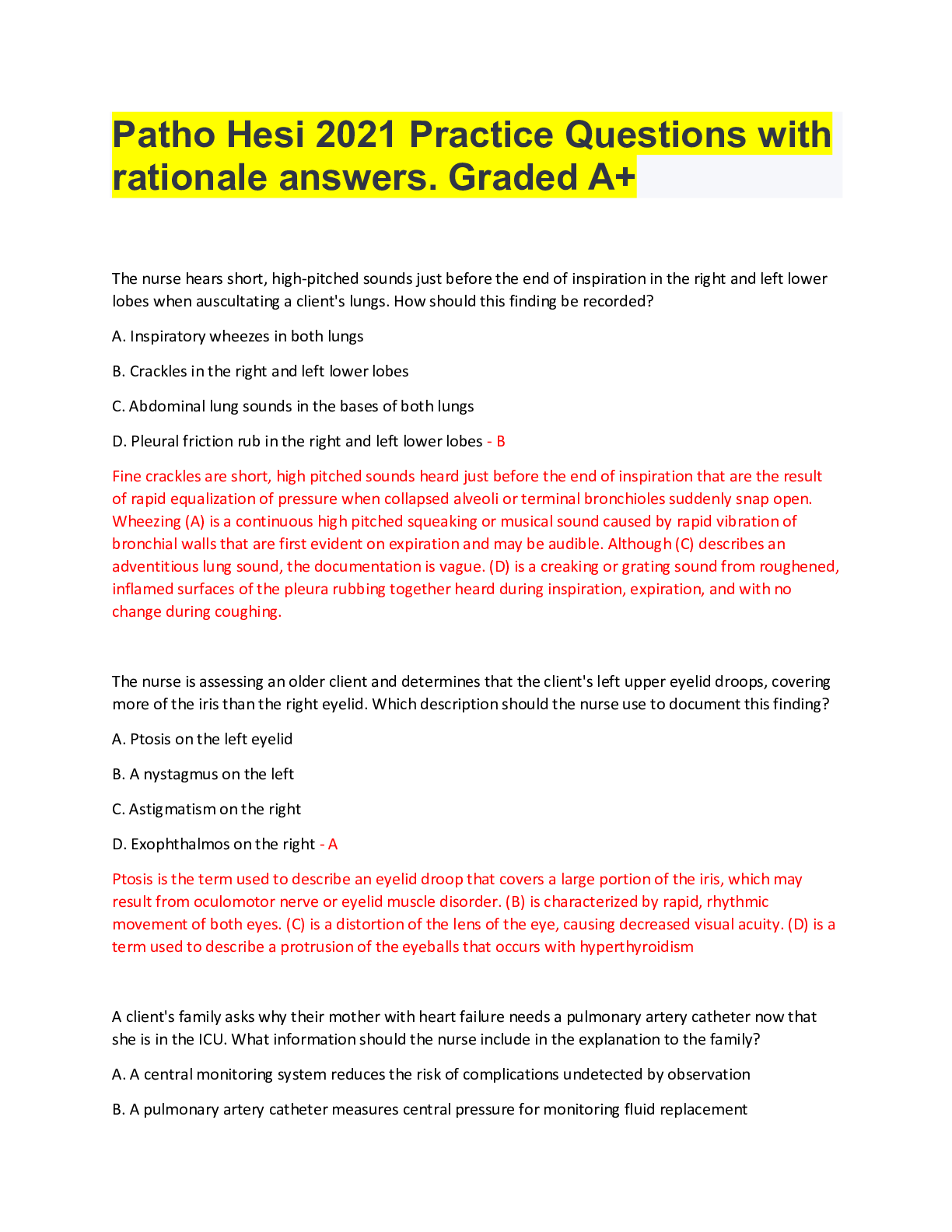
Reviews( 0 )
Document information
Connected school, study & course
About the document
Uploaded On
Mar 28, 2022
Number of pages
19
Written in
Additional information
This document has been written for:
Uploaded
Mar 28, 2022
Downloads
0
Views
36

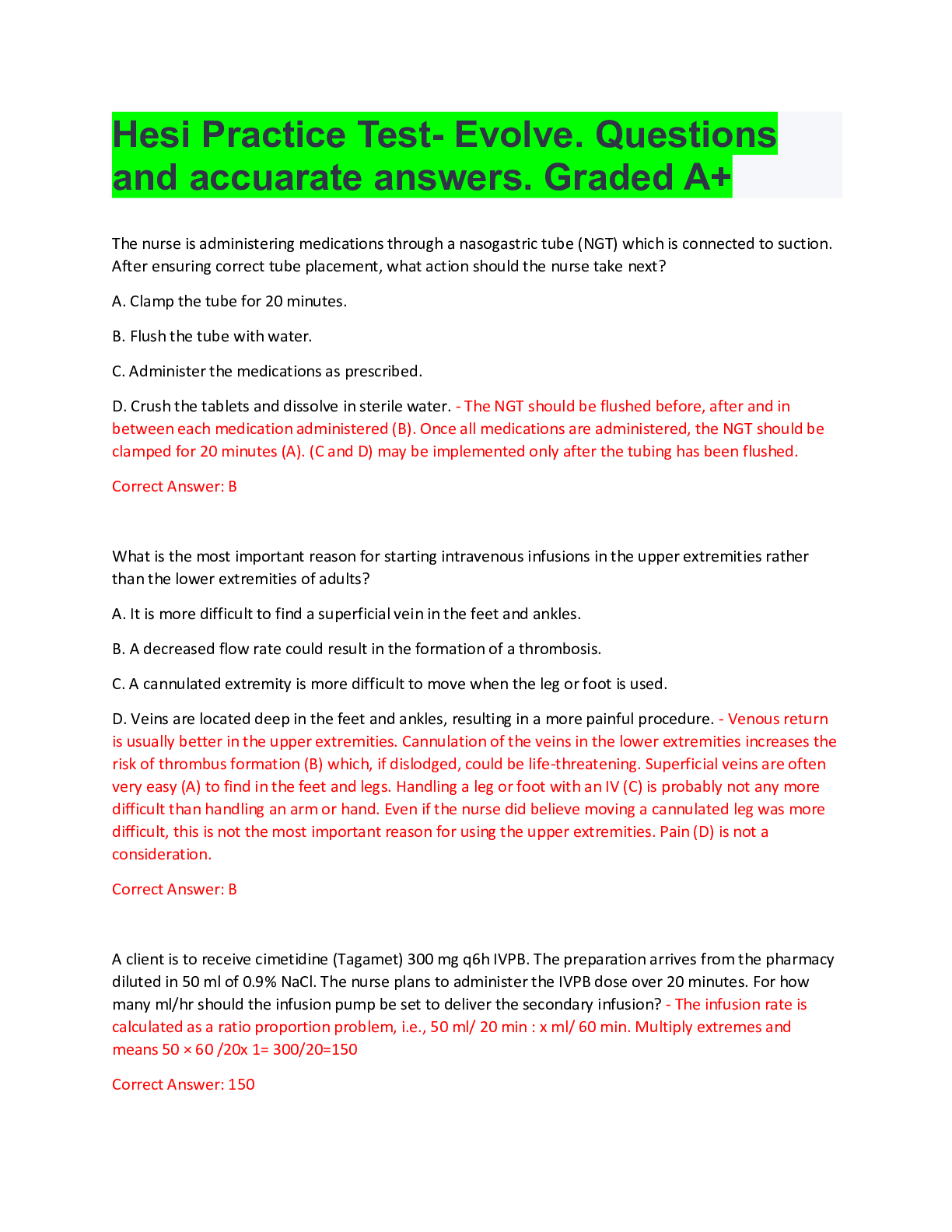
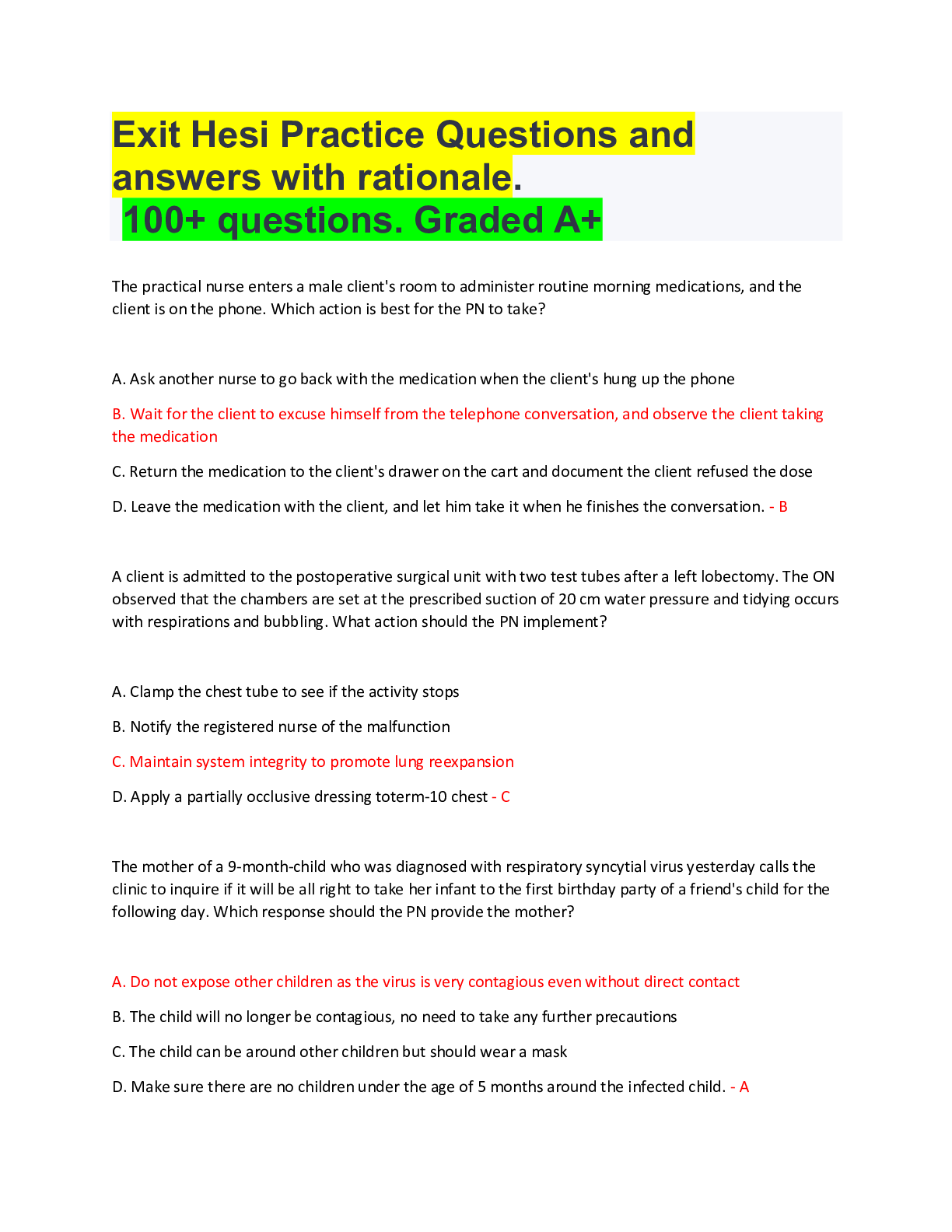

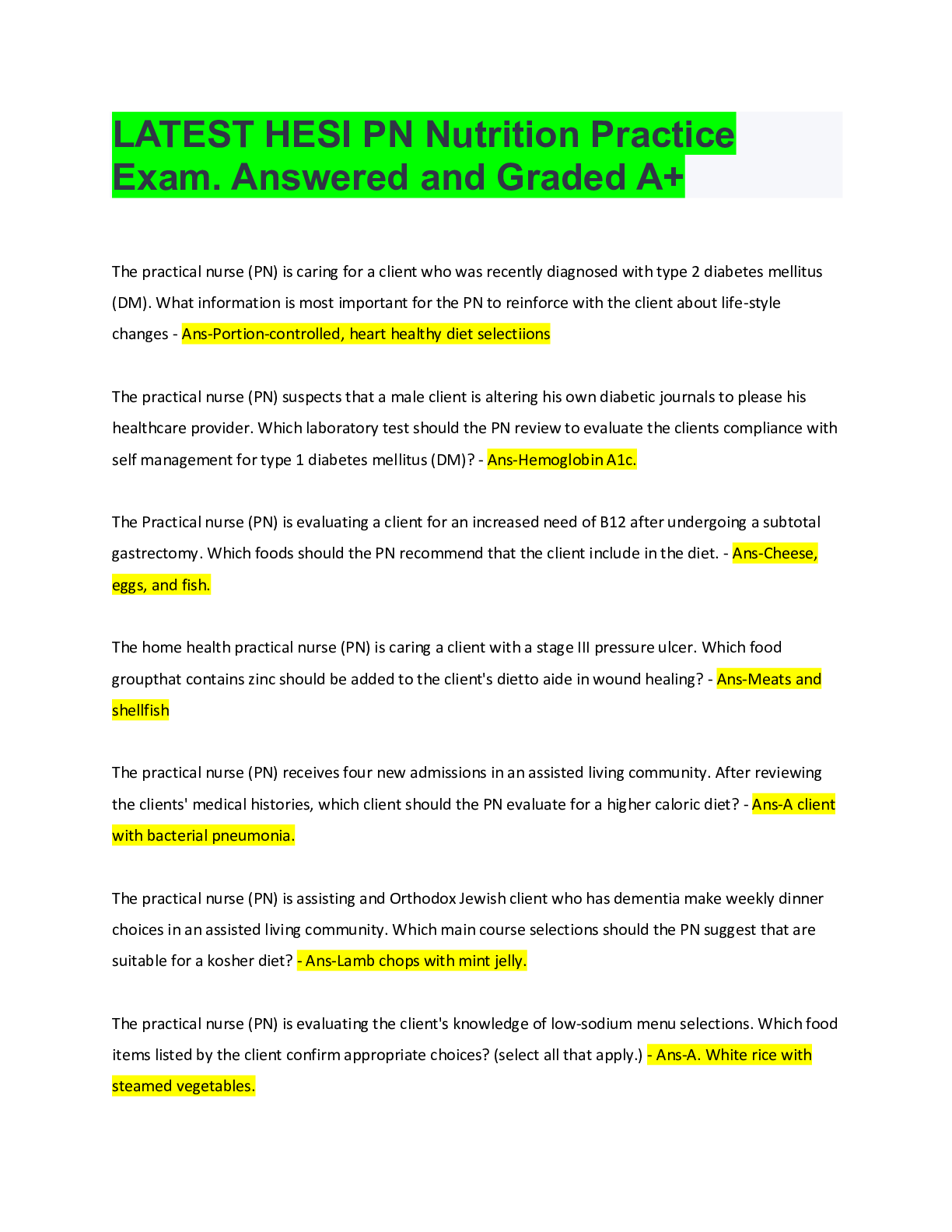


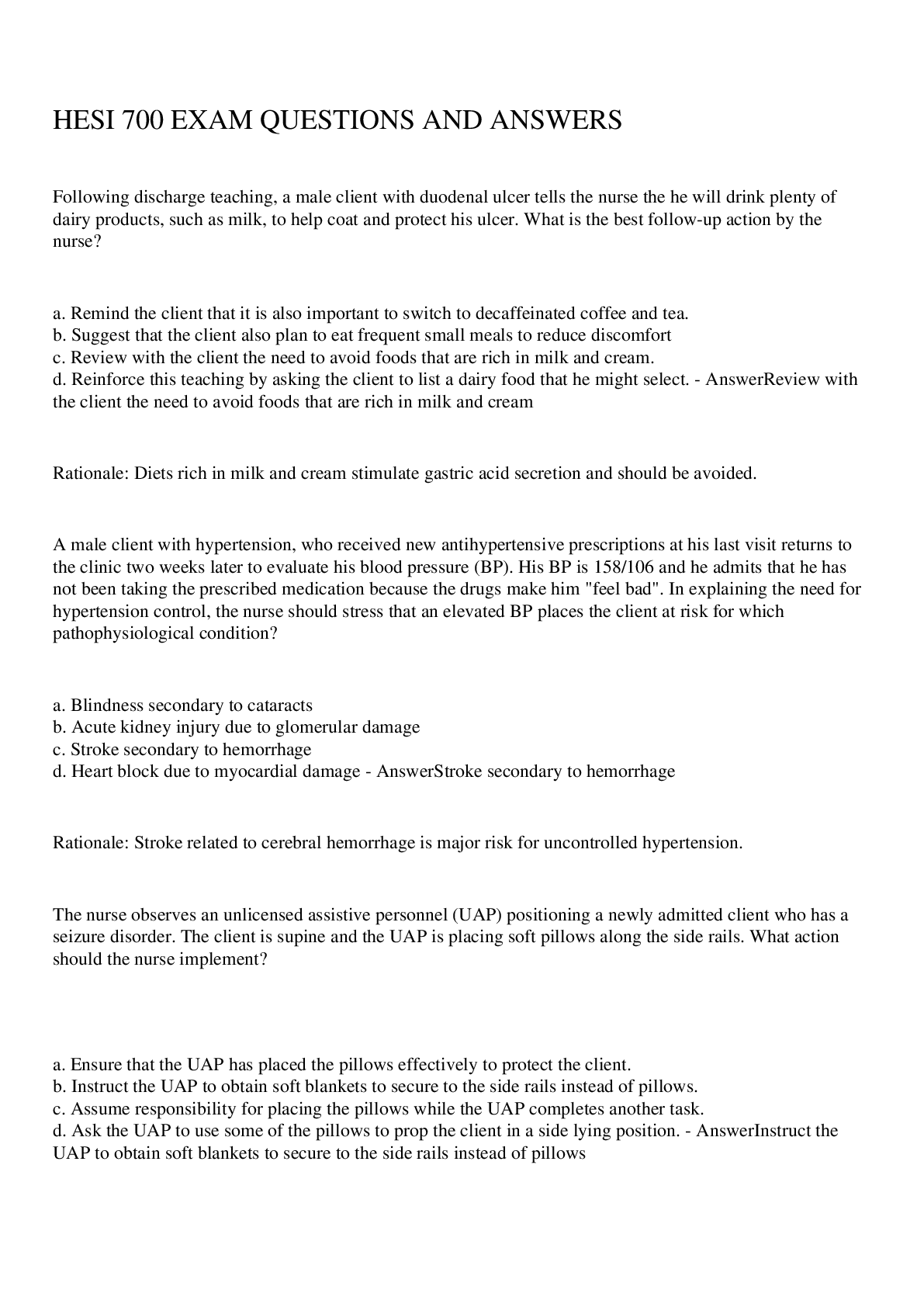


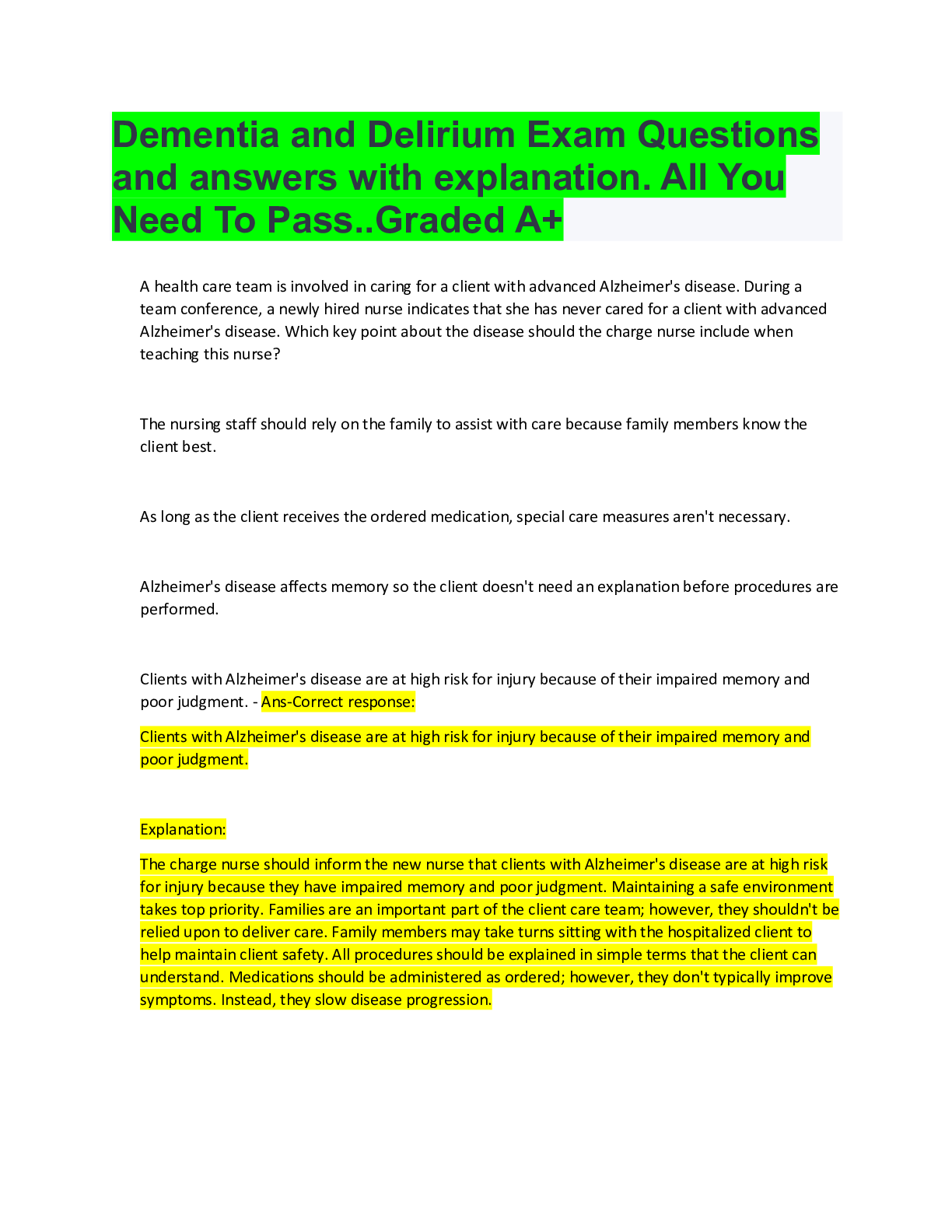


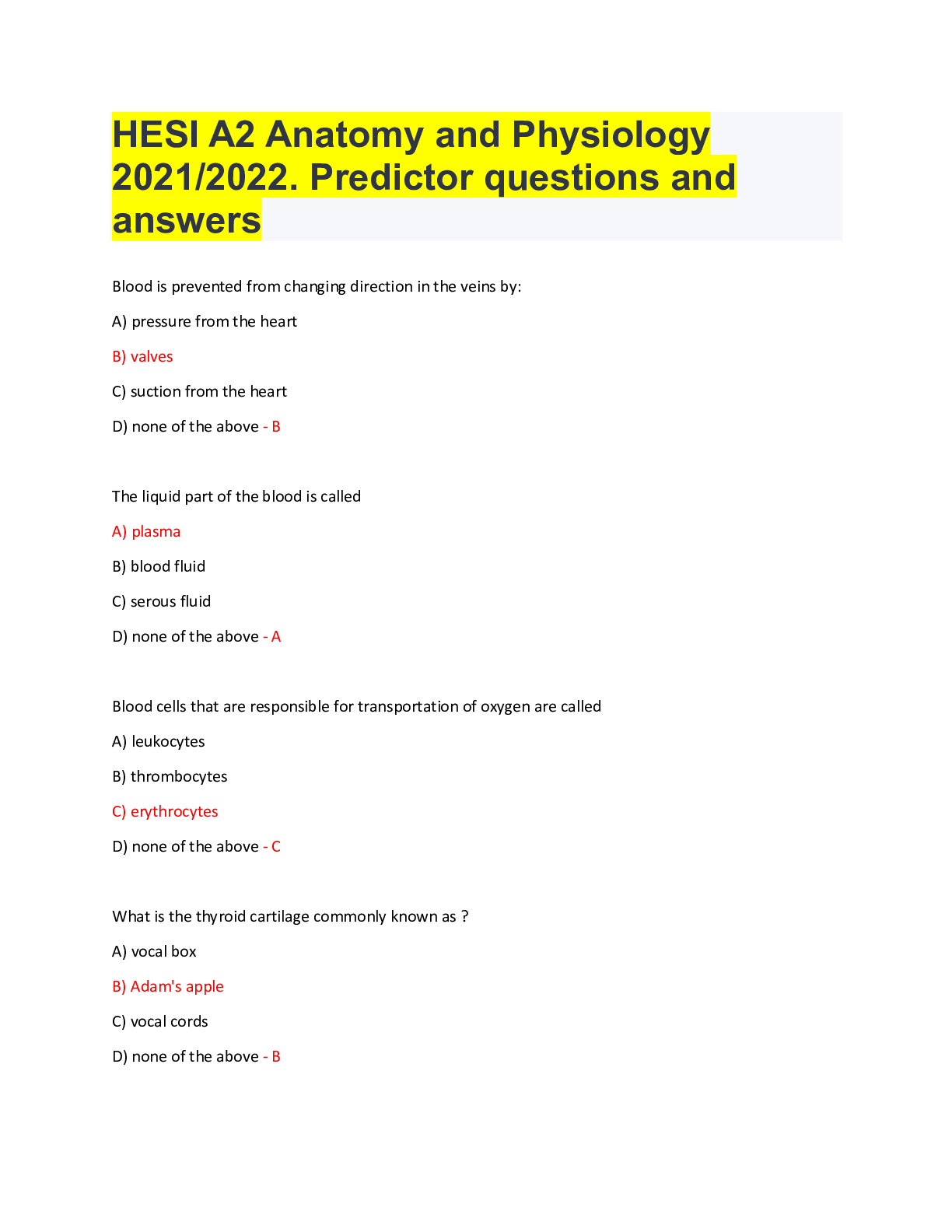

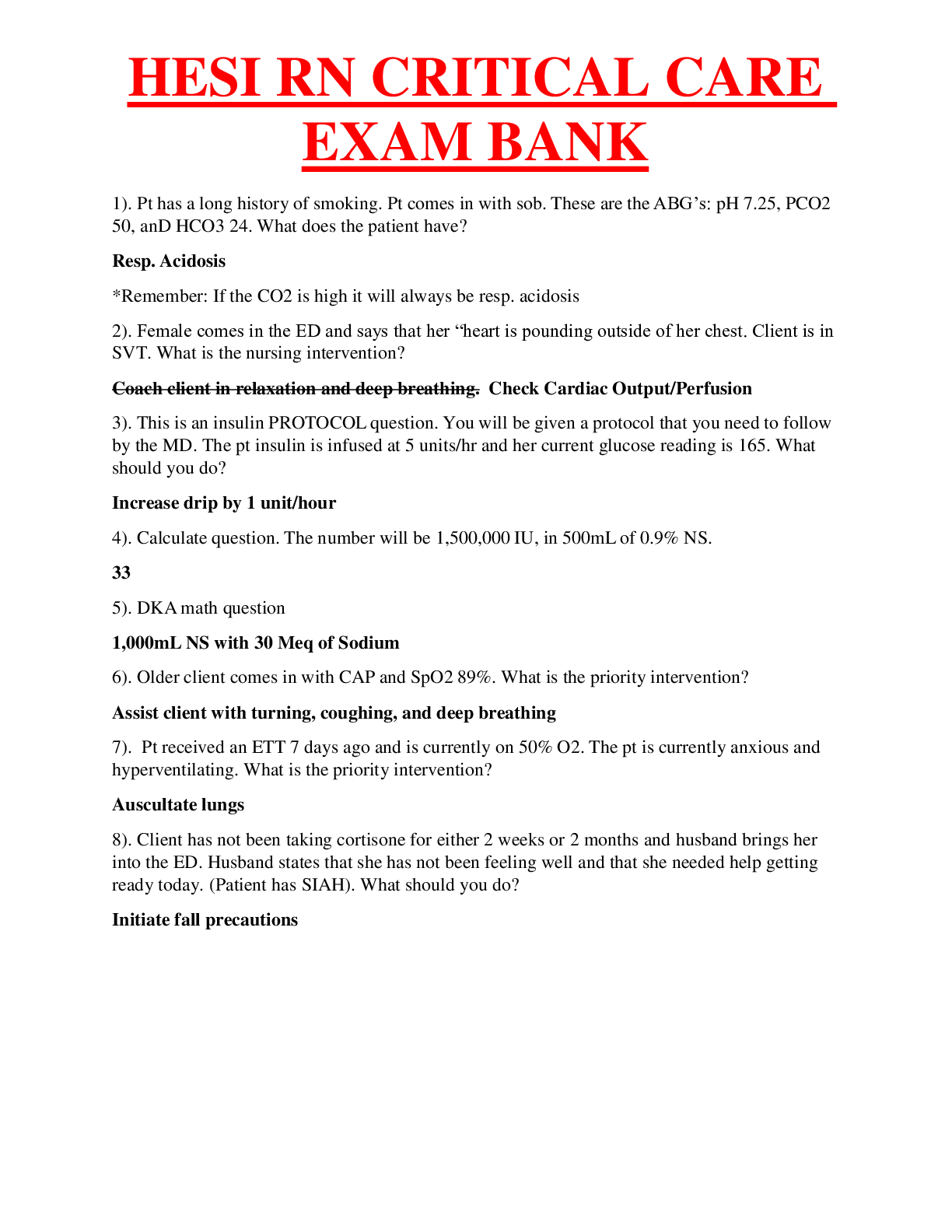
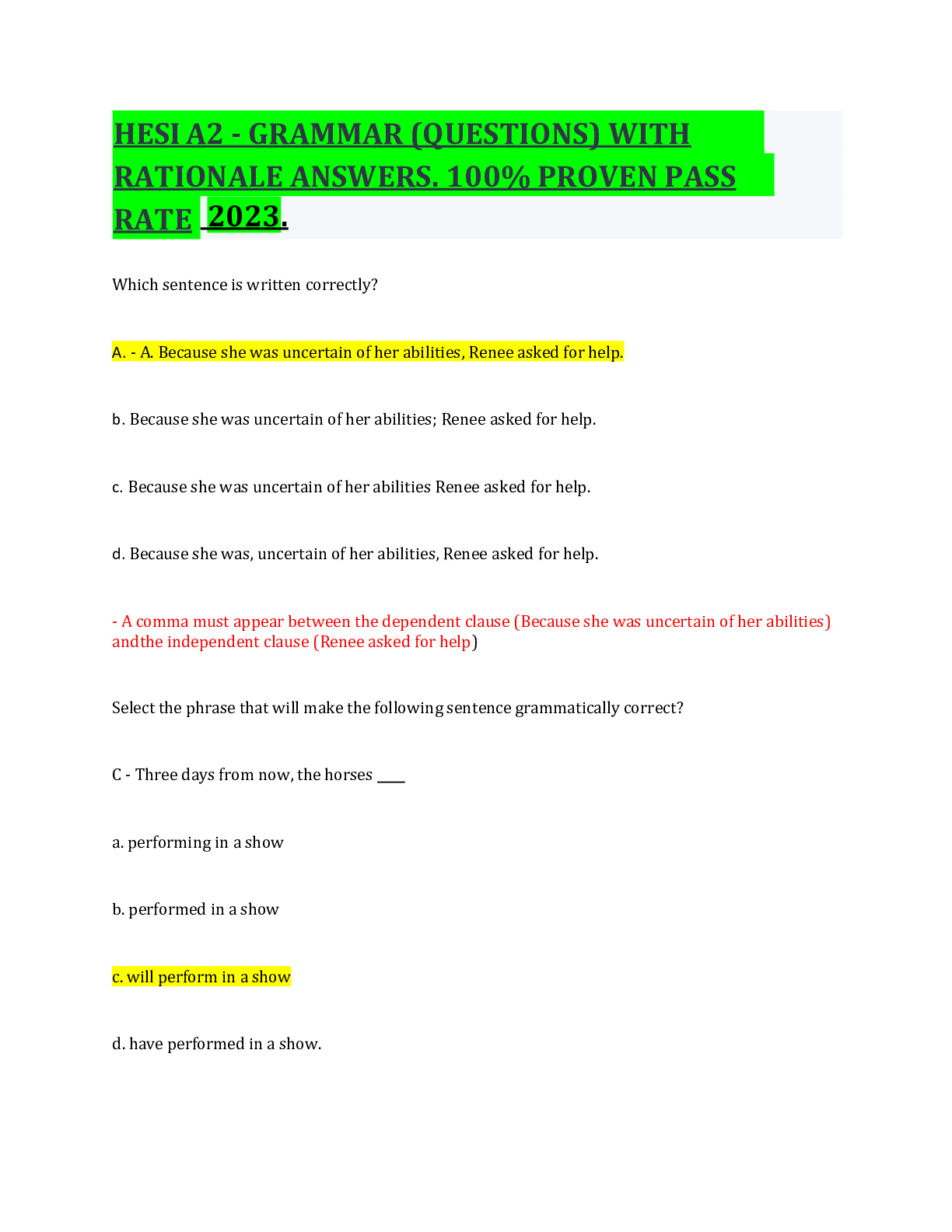
.png)
.png)

